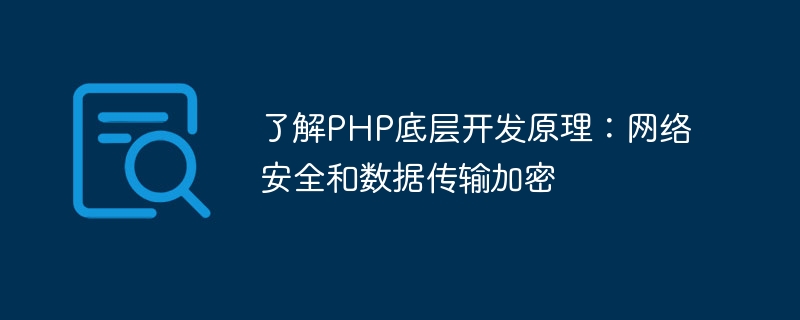

PHP is a programming language widely used in web development. Its underlying development principles involve many aspects, among which network security and data transmission encryption are extremely important parts. This article will delve into the network security and data transmission encryption issues in the underlying development principles of PHP.
Network security refers to the act of protecting network systems and data in the network technology environment and preventing unauthorized access, use, disclosure, interference, and destruction of network systems and data. Network security issues can be considered from multiple dimensions, such as firewalls, intrusion detection systems, etc. For PHP underlying development, the most common network security issues are cross-site scripting attacks (XSS) and cross-site request forgery (CSRF).
Cross-site scripting attack is an attack method that obtains users' sensitive information or performs illegal operations by inserting malicious script code into Web pages. PHP underlying development can ensure network security by preventing XSS attacks. PHP provides functions such as htmlspecialchars() and htmlentities(), which can filter and escape data to prevent the execution of malicious code. In addition, developers should also strengthen the validation of user input and avoid outputting unvalidated data directly to the front-end page.
Cross-site request forgery is a means of attack. The attacker deceives users into performing certain operations by forging requests, such as changing account passwords, transferring funds, etc. PHP underlying development can prevent CSRF attacks by setting Token. Token is a randomly generated token associated with a user session and is used to verify the legitimacy of the request. When the user sends a request, PHP will verify whether the Token in the request is consistent with the Token stored in the user's session, and reject the request if it is inconsistent.
In addition to network security, data transmission encryption is also an issue that cannot be ignored in the underlying development of PHP. During network transmission, data may be intercepted and tampered with by attackers, so data needs to be encrypted and protected. PHP provides some encryption functions and classes, such as md5() and password_hash(), which can encrypt data. Developers can use these functions to encrypt sensitive information such as user passwords and transfer the encrypted data to the server for storage.
In addition to one-way encryption, PHP also supports the use of symmetric encryption and asymmetric encryption algorithms to ensure the security of data transmission. Symmetric encryption algorithms use the same key for encryption and decryption and are fast but slightly less secure. The asymmetric encryption algorithm uses a pair of keys, the public key is used to encrypt data, and the private key is used to decrypt data. It is more secure but slightly slower. PHP provides openssl extensions that make it easy to use various symmetric and asymmetric encryption algorithms.
In summary, the underlying development of PHP involves two important issues: network security and data transmission encryption. Developers should pay attention to network security and take appropriate security measures to prevent cross-site scripting attacks and cross-site request forgery. In addition, for data transmission encryption, developers can use the encryption functions and classes provided by PHP, or use symmetric encryption and asymmetric encryption algorithms to ensure the security of data transmission. Through reasonable network security and data transmission encryption measures, the security and reliability of PHP's underlying development can be effectively improved.
The above is the detailed content of Understand the underlying development principles of PHP: network security and data transmission encryption. For more information, please follow other related articles on the PHP Chinese website!




